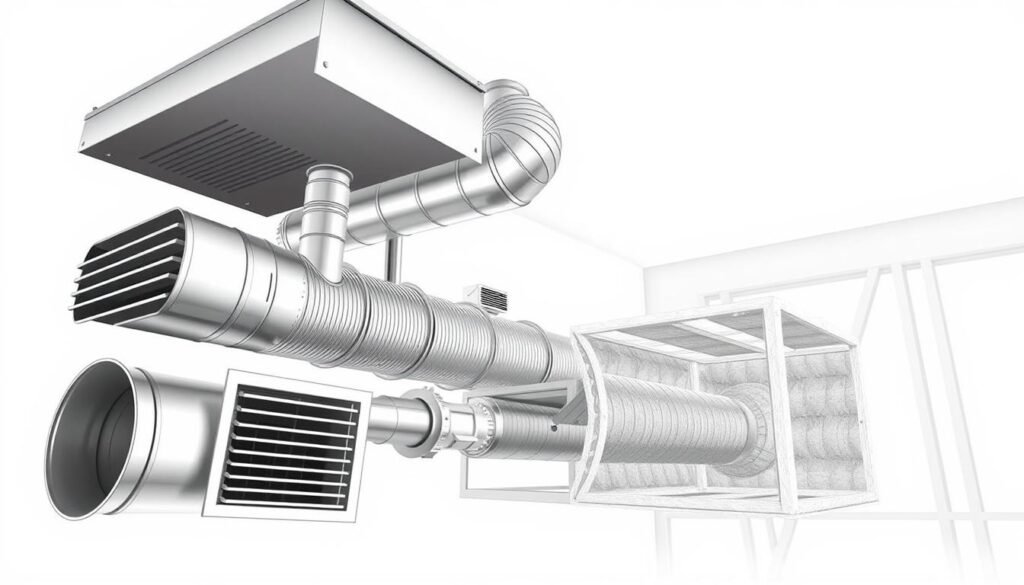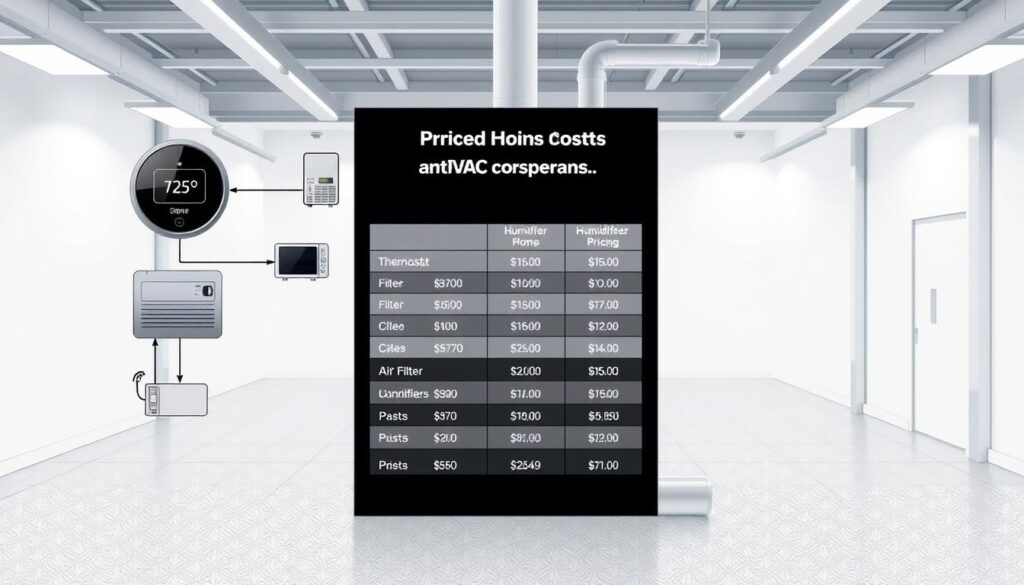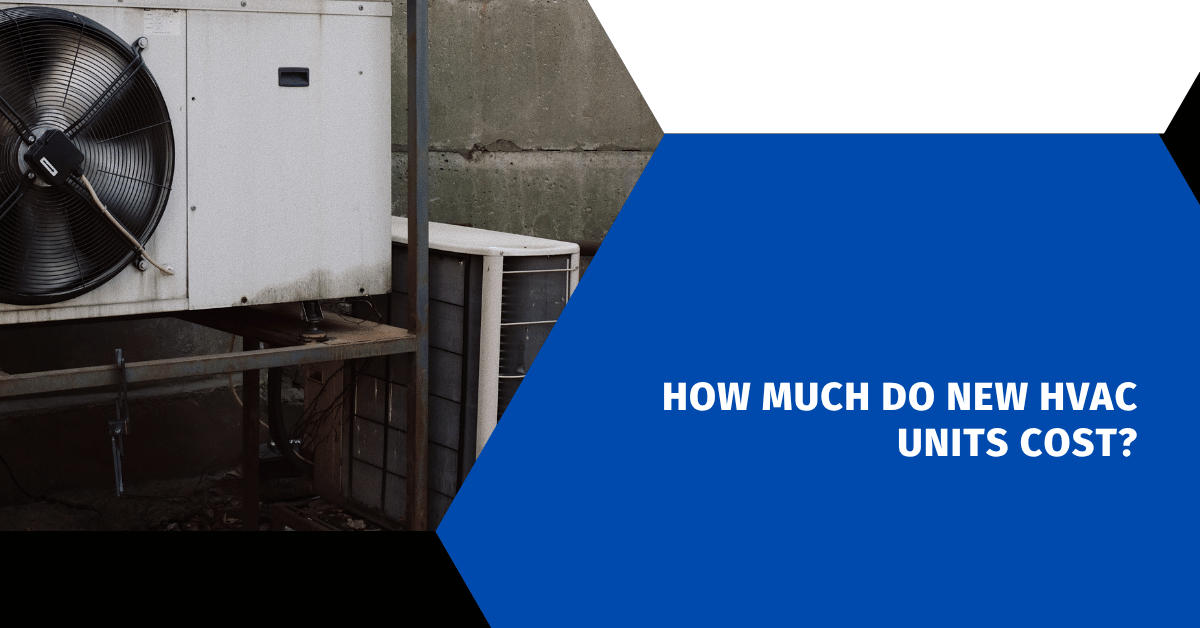Affiliate Disclosure
HVAC Guide Guys is a participant in the Amazon Services LLC Associates Program, an affiliate advertising program designed to provide a means for sites to earn advertising fees by advertising and linking to Amazon.
How Much Do New HVAC Units Cost? Are you curious about the cost of a new HVAC system? Knowing the price can help you plan your budget for this important home upgrade.

Homeowners usually spend around $7,500 on HVAC installation. Prices can vary from $5,000 to $12,500. This depends on several factors that affect your system’s needs.
Your home’s size, current setup, energy efficiency goals, and chosen equipment all play a role. Getting a professional to assess your home is key to finding the best and most affordable solution.
Key Takeaways
- National average HVAC installation cost ranges from $5,000 to $12,500
- Total price depends on home size and system complexity
- Professional evaluation helps determine accurate pricing
- Energy efficiency significantly impacts long-term costs
- Multiple factors influence overall HVAC unit expenses
Table of Contents
Understanding HVAC System Basics and Cost Ranges
Knowing your HVAC system is key to home comfort. It keeps your living space cozy. The cost of central air can change a lot, so it’s good to know what affects prices.
HVAC systems are more than just heaters and coolers. They manage your home’s temperature and air quality. This means they do more than just heat or cool your home.
Key Components of an HVAC System
- Heating unit (furnace or heat pump)
- Cooling unit (air conditioner)
- Ventilation system
- Thermostat
- Ductwork
Average Cost Overview
Getting a new HVAC system can cost between $5,000 and $12,500. Prices change based on several important factors.
| System Type | Average Cost Range | Typical Home Size |
|---|---|---|
| Basic Split System | $5,000 – $7,500 | 1,000-1,500 sq ft |
| Mid-Range System | $7,500 – $10,000 | 1,500-2,500 sq ft |
| High-End System | $10,000 – $12,500 | 2,500+ sq ft |
Factors Affecting Installation Prices
Several things can change the cost of central air. Knowing these can help you choose the right HVAC for your home.
- Home size and layout
- System efficiency ratings
- Local climate conditions
- Installation complexity
- Brand and equipment quality
Your specific needs will help pick the best HVAC for your home. A professional can give you a detailed estimate based on your situation.
Explore Our HVAC Shop
Looking for top-rated HVAC tools, parts, and accessories? Visit our shop and find the perfect solution for your needs.
Visit the ShopTypes of HVAC Units and Their Price Points
Exploring hvac equipment prices reveals various HVAC units for different needs. Knowing these options helps you choose wisely for your furnace replacement cost and system investment.
- Split System Units: Traditional setup with indoor and outdoor components
• Average price range: $3,000 – $7,500
• Best for most residential homes - Packaged Units: Compact single-unit systems
• Average price range: $2,500 – $5,500
• Ideal for smaller spaces or homes with limited installation areas - Ductless Mini-Split Systems: Flexible zoned heating and cooling
• Average price range: $2,000 – $6,000
• Perfect for room additions or homes without existing ductwork
Prices for hvac equipment vary based on system capacity, efficiency, and local installation costs. Heat pumps usually cost between $4,000 and $8,000. Central air conditioning systems can range from $3,500 to $7,500.
When looking at furnace replacement cost, gas furnaces are often cheaper upfront. They cost between $2,500 and $6,000. Electric furnaces might be less expensive at first but can cost more to run.
Pro tip: Always consult with a professional HVAC technician to determine the most suitable unit for your specific home requirements and budget.
How Much Do New HVAC Units Cost for Different Home Sizes
Choosing the right HVAC system depends on your home’s size and needs. The cost of a new HVAC unit changes with the square footage. This affects the unit’s size and the total cost for your home.
It’s important to know how your home’s size affects your HVAC system. Each home size needs a specific HVAC capacity. This ensures your system works well and saves energy.
Small Homes (Under 1,000 sq ft)
Small homes need a smaller HVAC system. They usually require:
- 1.5 to 2-ton unit capacity
- Estimated cost range: $3,000 – $5,500
- Compact design for efficient cooling and heating
Medium Homes (1,000-2,000 sq ft)
Medium homes need a stronger HVAC system. You can expect:
- 2.5 to 3.5-ton unit capacity
- Estimated cost range: $5,500 – $8,500
- Enhanced energy efficiency features
Large Homes (2,000+ sq ft)
Large homes need a powerful HVAC system. They require:
- 4 to 5-ton unit capacity
- Estimated cost range: $8,500 – $12,000
- Advanced zoning capabilities
“Choosing the right HVAC system size is key for comfort and saving on energy costs.” – HVAC Industry Expert
Pro tip: Always talk to a professional HVAC technician. They can find the best system for your home and local climate.
Explore Our HVAC Shop
Looking for top-rated HVAC tools, parts, and accessories? Visit our shop and find the perfect solution for your needs.
Visit the ShopEnergy Efficiency Ratings and Cost Impact
When you think about upgrading your HVAC, knowing about energy efficiency is key. The Seasonal Energy Efficiency Ratio (SEER) and Annual Fuel Utilization Efficiency (AFUE) are important. They affect how much you pay for your heating and cooling systems.
Energy efficiency ratings show how much energy your HVAC uses. A higher SEER rating means your system is more efficient. This can lower your energy bills over time.
- A system with a 16 SEER rating is more efficient than one with a 13 SEER rating
- Higher efficiency systems cost more at first but save money later
- Energy Star certified units might get you tax credits
The price of your heating and cooling system changes with efficiency levels. A standard unit might cost $3,000-$5,000, while a high-efficiency one could be $6,000-$10,000. Even though it’s a big upfront cost, the savings over time can make it worth it.
Investing in a high-efficiency HVAC system is like putting money in an energy savings account.
When looking at HVAC upgrade costs, here’s what you need to know:
- 13-14 SEER: Standard efficiency
- 15-16 SEER: Mid-range efficiency
- 17-20 SEER: High efficiency
- 21+ SEER: Premium efficiency
Choosing the right efficiency rating depends on your climate, home size, and budget. Talking to an HVAC expert can help you find the best option for your needs.
Installation Costs and Labor Expenses
When planning a new HVAC system, it’s important to know all the costs involved. The price of the unit is just the beginning. Labor, materials, and extra fees can greatly affect your total cost.
Professional HVAC installation has many cost factors to consider. The project’s complexity and your home’s needs will decide the final cost.
Labor Rate Variations
HVAC labor rates change based on several things:
- Where you live and local rates
- How complex the installation is
- The technician’s experience and skills
- How busy HVAC services are during the season
Labor costs usually fall between $75 to $250 per hour. Rates are often higher in cities than in rural areas.
Additional Installation Materials
Many extra materials are needed for the job:
- Refrigerant lines
- Electrical wiring
- Mounting brackets
- Insulation materials
- Sealants and connectors
These can add $500 to $1,500 to your total cost. They ensure a thorough and professional job.
Permit and Inspection Fees
Local governments need permits for HVAC installations to keep things safe and legal. These fees are different but usually between $250 to $800. HVAC pros will take care of permits and inspections for you.
Pro tip: Always check with your local building department about permits before starting your HVAC project.
Ductwork Considerations and Pricing

Ductwork is key in your central air conditioning cost. It affects your HVAC system’s performance. Good ductwork means better air flow and can lower your hvac equipment prices.
Your home’s ductwork is like its circulatory system. Bad ducts can cut system efficiency by 20%. This means higher energy bills and uneven cooling.
- New ductwork installation typically ranges from $1,000 to $5,000
- Factors affecting ductwork costs include home size, complexity, and material
- Duct material options include sheet metal, flex duct, and fiberglass duct board
When looking at ductwork, remember these important pricing factors:
| Duct Type | Cost per Linear Foot | Best For |
|---|---|---|
| Sheet Metal | $10-$20 | Durability and long-term performance |
| Flexible Ductwork | $4-$8 | Tight spaces and easier installation |
| Fiberglass Duct Board | $7-$15 | Noise reduction and insulation |
Quality ductwork boosts your HVAC system’s efficiency. It can also cut down on long-term costs. Get a pro to find the best ductwork for your home.
Explore Our HVAC Shop
Looking for top-rated HVAC tools, parts, and accessories? Visit our shop and find the perfect solution for your needs.
Visit the ShopBrand Comparison and Price Ranges
When looking to upgrade your HVAC, knowing the different brands is key. The prices of AC units vary a lot, depending on the brand and quality. This gives homeowners many options to choose from, based on their budget and needs.
Choosing the right HVAC brand means finding a balance between performance, reliability, and cost. We’ll look at three main categories to help you make a good choice.
Premium Brands: Top-Tier Performance
Premium HVAC brands like Carriers and Lennox are at the top. They offer high-quality and the latest technology. These brands have the best energy efficiency and advanced features.
- Highest efficiency ratings
- Advanced technological features
- Longer warranty periods
- Higher upfront costs
Mid-Range Options: Balanced Performance
Trane and American Standard are mid-range brands. They offer great value for those looking for reliable performance without spending too much. These units have good efficiency and are priced well.
| Brand | Average Cost Range | Efficiency Rating |
|---|---|---|
| Trane | $3,500 – $7,500 | 16-20 SEER |
| American Standard | $4,000 – $8,000 | 14-18 SEER |
Budget-Friendly Choices
If you’re watching your budget, Goodman and York are good options. They offer affordable prices without sacrificing basic functionality.
- Lower initial investment
- Standard efficiency ratings
- Shorter warranty periods
- Suitable for smaller spaces
Remember, your home’s needs, local climate, and future energy savings should influence your choice. This will help you pick the best HVAC unit for you.
Additional Components and Their Costs
When looking at HVAC costs for homes, people often miss out on extra parts that boost system performance. These extras not only make the air cleaner but also affect the price of HVAC equipment.

Looking into optional HVAC parts can make your home more comfy and efficient. Here are some common upgrades and their prices:
- Air Purifiers: Cost between $100 and $2,500, based on the tech and area it covers
- Whole-House Dehumidifiers: Usually priced between $1,300 and $2,800
- Smart Thermostats: Prices range from $100 to $500
- Humidity Control Systems: Costs from $200 to $1,500
Knowing about these extra parts helps you choose wisely for your HVAC system’s performance and cost.
| Component | Price Range | Primary Benefit |
|---|---|---|
| Air Purifier | $100 – $2,500 | Removes airborne contaminants |
| Whole-House Dehumidifier | $1,300 – $2,800 | Reduces moisture and prevents mold |
| Smart Thermostat | $100 – $500 | Improves energy efficiency |
| Humidity Control System | $200 – $1,500 | Maintains optimal indoor humidity |
While these parts add to the cost, they greatly enhance your home’s comfort and air quality. Think about each option carefully, based on your needs and budget.
Explore Our HVAC Shop
Looking for top-rated HVAC tools, parts, and accessories? Visit our shop and find the perfect solution for your needs.
Visit the ShopFinancing Options for HVAC Installation
Understanding the cost of a new HVAC system can be tough for homeowners. A new HVAC system is a big investment. But, there are many financing options to help make it easier to pay for.
Your main financing choices are:
- Home Equity Loans: Use your home’s equity for lower interest rates
- Personal Loans: Get quick approval but with possibly higher interest rates
- HVAC Company Installment Plans: Special financing from manufacturers
- Credit Card Financing: A short-term fix for smaller costs
When looking at financing for your new HVAC system, think about these key points:
- Interest rates
- Repayment terms
- Potential tax deductions
- Long-term financial impact
Many HVAC makers offer zero-interest financing for certain buyers. Talk to local contractors about any special deals that could lower your costs.
“Smart financing can turn a big upfront cost into easy monthly payments.”
Always compare different financing options. This way, you can find the best fit for your budget and future financial plans.
Conclusion
Knowing how much new HVAC units cost is key for homeowners looking to upgrade. Prices range from $5,000 to $12,500. This depends on your home’s size, the unit’s efficiency, and how hard it is to install.
Your furnace replacement cost will depend on your home’s needs and the equipment you choose. It’s not just about the price. Energy-efficient models might cost more upfront but save on bills later.
Think about the system’s long-term performance and any rebates you might get. This helps balance the initial cost with future savings. It’s important to consider your home’s specific needs and the system’s lifespan.
Look into different brands and get quotes from several professionals. Also, check out financing options to get the most out of your money. A good HVAC system makes your home more comfortable, increases its value, and saves energy.
Working with trusted HVAC experts is essential. They can help you choose the right system for your home. Remember, keeping your system well-maintained can make it last longer and work better.
Regular maintenance, annual checks, and quick repairs are key. They protect your investment and keep your home comfortable for years.

